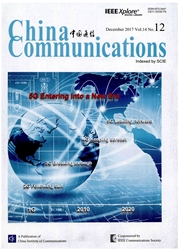

 中文摘要:
中文摘要:
In this paper, a novel idea for rate allocation combining both vertical coupling and horizontal coupling constraints is proposed, and a unified utility function to balance two paradoxical issues: efficiency and fairness, revenue and cost is elaborated in WCDMA networks. Then, the optimal rate allocation problem is formulated as a network utility maximization(NUM) model based on cross-layer design and end-to-end congestion control, aiming at exploring the impacts of wired networks and the characteristics of radio access networks(RANs) on rate allocation. Furthermore, a distributed algorithm is derived, which can effectively match load states between RANs and wired networks, followed by a detailed illustration of the practical implementations. Numerical results demonstrate a signifi cant performance improvement in the end-to-end throughput.
 英文摘要:
英文摘要:
In this paper, a novel idea for rate allocation combining both vertical coupling and horizontal coupling constraints is proposed, and a unified utility function to balance two paradoxical issues: efficiency and fairness, revenue and cost is elaborated in WCDMA networks. Then, the optimal rate allocation problem is formulated as a network utility maximization (NUM) model based on cross-layer design and end-to-end congestion control, aiming at exploring the impacts of wired networks and the characteristics of radio access networks (RANs) on rate allocation. Furthermore, a distributed algorithm is derived, which can effectively match load states between RANs and wired networks, followed by a detailed illustration of the practical implementations. Numerical results demonstrate a significant performance improvement in the end-to-end throughput.
 同期刊论文项目
同期刊论文项目
 同项目期刊论文
同项目期刊论文
 Bandwidth-Aware High-Throughput Routing With Successive Interference Cancelation in Multihop Wireles
Bandwidth-Aware High-Throughput Routing With Successive Interference Cancelation in Multihop Wireles Energy Ef?ciency and Delay Tradeoff in Device-to-Device Communications Underlaying Cellular Networks
Energy Ef?ciency and Delay Tradeoff in Device-to-Device Communications Underlaying Cellular Networks Optimal Rate Allocation Based on Cross-Layer Design and End-to-End Congestion Control in WCDMA Netwo
Optimal Rate Allocation Based on Cross-Layer Design and End-to-End Congestion Control in WCDMA Netwo Energy-Ef?cient Subcarrier Assignment and Power Allocation in OFDMA Systems With Max-Min Fairness Gu
Energy-Ef?cient Subcarrier Assignment and Power Allocation in OFDMA Systems With Max-Min Fairness Gu Joint spectrum-ef?cient routing and scheduling with successive interference cancellation in multihop
Joint spectrum-ef?cient routing and scheduling with successive interference cancellation in multihop Efficient Link Scheduling with Joint Power Control and Successive Interference Cancellation in Wirel
Efficient Link Scheduling with Joint Power Control and Successive Interference Cancellation in Wirel End-to-End Delay Distribution Analysis for Stochastic Admission Control in Multi-hop Wireless Networ
End-to-End Delay Distribution Analysis for Stochastic Admission Control in Multi-hop Wireless Networ 期刊信息
期刊信息
